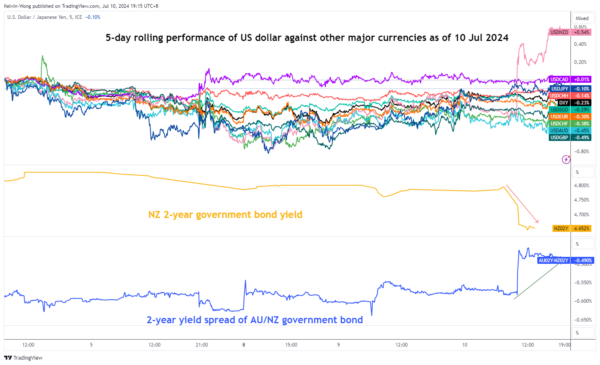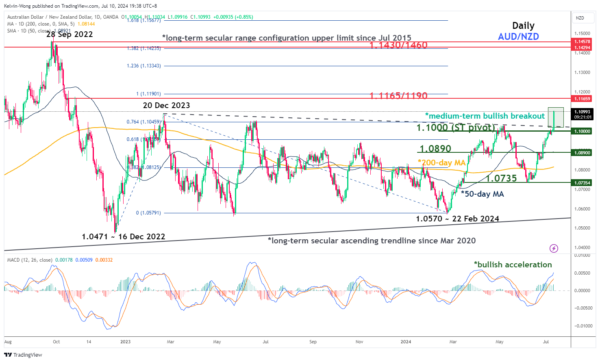- The Kiwi is the worst intraday performer among the major currencies as it slumped to a 4-week low against the US dollar.
- A dovish tilt in the latest RBNZ monetary policy statement has triggered a narrowing of the yield discount between the 2-year Australian and New Zealand government bonds.
- AUD/NZD has staged a medium-term bullish breakout above 1.1000 key support.
Since our last publication, the price actions of the AUD/NZD have inched lower to break below its 200-day moving average on 4 June and traded lower in the next three days to print an intraday low of 1.0731 on 7 June.
After that, the AUD/NZD staged a bullish reversal of +274 pips/+2.56% in the next four weeks to close at 1.1006 on Tuesday, 9 July which has almost recoupled the prior loss from its 7 May high of 1.1024.
Since the start of today’s Asian session, 10 July, the AUD/NZD has further extended its intraday gains by +96 pips/+0.87% to hit a 52-week high of 1.1103 due to a surprise dovish monetary policy statement released by New Zealand central bank, RBNZ after the conclusion on the outcome of its monetary policy decision.
A 180-degree turn from RBNZ from hawkish to dovish
The RBNZ has kept its key short-term official cash rate unchanged at 5.50% for the eighth consecutive meeting which is not a surprise to market participants. The big shock came from the tonality of its monetary policy statement where it offered a dovish tilt that implied that the current high interest rate environment in New Zealand has fed through to domestic demand more strongly than expected and a range of business and consumer-based surveys, and high-frequency data have pointed to a decline in economic activities.
That’s a 180-degree change from its prior May monetary policy statement where RBNZ’s stance was mildly hawkish as its officials had discussed the case to consider another interest rate hike and signalled that the first cut on its policy rate to only take place after Q2 2025.
A bad day for the Kiwi as it is the worst performer among the major currencies
Fig 1: 5-day rolling performance of US dollar pairs with 2-year yield spread of AU/NZ government bonds as of 10 Jul 2024 (Source: TradingView, click to enlarge chart)
Today’s “abrupt” change in RBNZ’s monetary policy statement tonality from hawkish to dovish has triggered a significant intraday sell-off of -0.86% in the Kiwi against the US dollar where it slumped the most in almost four weeks, and it is the weakest currency by a far stretch against the US dollar at this time of the writing based on a 5-day rolling performance basis (see Fig 1).
Also, the short-term interest rate swaps market has now priced in two interest rate cuts by RBNZ before 2024 ends which led to the monetary policy-sensitive yield of the 2-year New Zealand government bond to drop by 15 basis points (bps) to 4.65%, its biggest single-day drop since 28 February (see Fig 1).
The current dramatic slide seen in the 2-year New Zealand government bond yield has triggered a further narrowing of yield discount between 2-year Australian and New Zealand government bonds from -0.58% to -0.48% which in turn supports a potential outperformance of the Aussie dollar against the Kiwi.
Potential bullish acceleration in AUD/NZD towards a long-term secular range resistance
Fig 2: AUD/NZD major and medium-term trends as of 10 Jul 2024 (Source: TradingView, click to enlarge chart)
In the lens of technical analysis, the AUD/NZD cross pair has staged a bullish breakout above its former medium-term range resistance that has capped prior rallies since 20 December 2023.
In addition, the MACD trend indicator has continued to trend upwards steadily above its zero centreline since 27 June which supports a medium-term uptrend phase that is likely to have kickstarted (see Fig 2).
If the 1.1000 key medium-term pivotal support holds, the AUD/NZD may see a further potential upmove within a long-term secular range configuration in place since July 2015 with the next medium-term resistances coming in at 1.1165/1190 and 1.1430/1460 (also the upper limit of the long-term secular range configuration).
On the flipside, failure to hold at 1.1000 suggests a failure bullish breakout and the AUD/NZD may resume its choppy corrective downward drift to expose the next medium-term supports at 1.0890 (also the 50-day moving average) and below it sees 1.0735 next.















